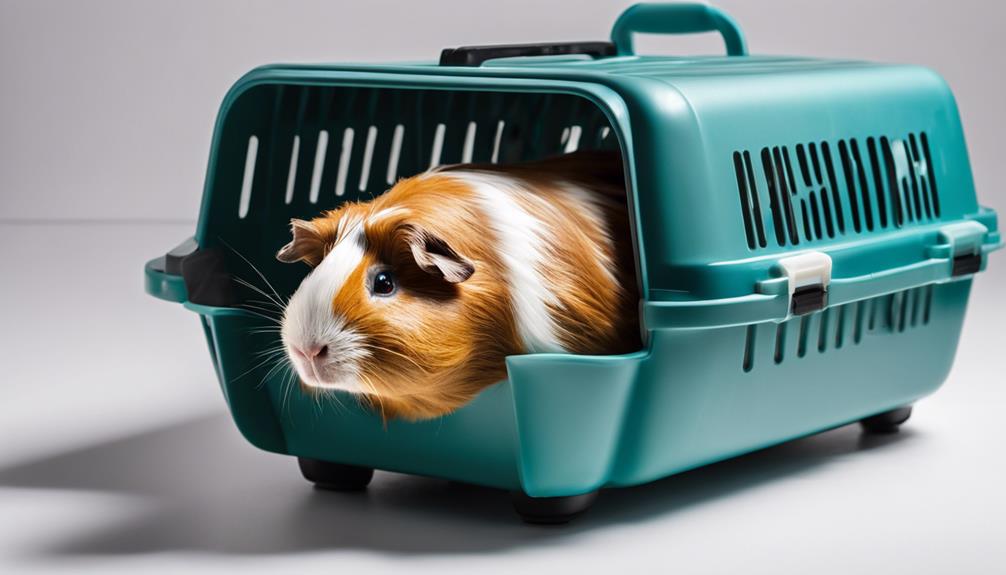What Temperature Is Safe for Traveling With Guinea Pigs?

Safe temperature for traveling with guinea pigs is between 65-75°F. Extreme temperatures can be harmful to their health.
Plan carefully to ensure a comfortable journey for your furry companions.
Key Takeaways
- Optimal temperature range for guinea pig travel is 65-75°F.
- Extreme temperatures can harm guinea pigs' health.
- Maintain stable temperatures to prevent stress and health issues.
- Risks of hypothermia below 60°F and heat stress above 80°F.
Importance of Temperature Control
Ensuring proper temperature control is paramount for the well-being and health of guinea pigs during travel. Temperature regulation and heat management are critical aspects to contemplate when setting out on a journey with these small, delicate creatures. Guinea pigs are sensitive to extreme temperatures; hence, maintaining a suitable environment is essential to prevent stress and potential health issues during transit.
Proper heat management involves providing a comfortable and stable temperature within the travel carrier. Extreme heat can lead to heatstroke, dehydration, and even death in guinea pigs. On the other hand, excessively cold temperatures can cause hypothermia and respiratory problems. It's essential to shield guinea pigs from direct sunlight and drafts while ensuring adequate ventilation to maintain a consistent temperature.
Optimal Temperature Range for Guinea Pigs
Maintaining the ideal temperature range is essential for the health and well-being of guinea pigs during travel. Guinea pigs are sensitive animals that require a specific climate to thrive. To guarantee their comfort and safety, understanding temperature regulation and climate considerations is vital.
| Temperature Range | Description |
|---|---|
| 65-75°F | Best range for guinea pigs |
| Below 60°F | Risk of hypothermia |
| Above 80°F | Risk of heat stress |
| Fluctuating Temperatures | May cause stress and health issues |
| Humidity Levels | Keep humidity levels between 30%-70% |
Guinea pigs are most comfortable in temperatures between 65-75°F, with humidity levels ranging from 30%-70%. Temperatures below 60°F can lead to hypothermia, while those exceeding 80°F pose a risk of heat stress. Fluctuating temperatures can also cause stress and health issues for these delicate creatures. When traveling with guinea pigs, it is necessary to ensure they are kept within this best temperature range to prevent any adverse effects on their well-being.
Signs of Heat Stress in Guinea Pigs

Guinea pigs can exhibit signs of heat stress when exposed to temperatures exceeding 80°F. These adorable creatures are sensitive to high temperatures, making it important for their caregivers to be vigilant for any indications of heat-related distress. Some common signs of heat stress in guinea pigs include excessive panting, lethargy, drooling, and seeking cool surfaces to lie on. It's vital to act promptly if you notice any of these symptoms to prevent heatstroke, a serious condition that can be life-threatening to guinea pigs.
To help your furry companions beat the heat, it's crucial to implement cooling techniques. Providing a shaded and well-ventilated environment, offering frozen water bottles wrapped in towels for them to lean against, and placing ceramic tiles in their cage for them to rest on can all help regulate their body temperature. Additionally, heatstroke prevention involves avoiding direct sunlight exposure, ensuring an adequate supply of fresh water, and never leaving them in a hot car. By being proactive and attentive, you can guarantee your guinea pigs stay comfortable and safe during warm weather.
Preparing for Cold Weather Travel
To guarantee the comfort and safety of guinea pigs during cold weather travel, it's crucial to pack warm bedding and provide cozy hideouts in their carriers.
These cozy accommodations will help them stay warm and cozy throughout the journey, shielding them from the chilling temperatures.
Packing Warm Bedding
Ensuring your guinea pig stays cozy during cold weather travel starts with carefully packing warm bedding that provides comfort and insulation. When selecting bedding options, contemplate materials like fleece, hay, or paper-based bedding that offer excellent insulation. These materials can help retain heat and keep your furry friend warm throughout the journey.
Additionally, you may want to contemplate temperature regulating accessories such as microwavable heating pads or heat lamps to provide extra warmth when needed. By choosing the right bedding and accessories, you can create a snug and comfortable environment for your guinea pig, ensuring they stay warm and happy during the travel in colder weather.
Providing Cozy Hideouts
Consider creating snug hideouts for your furry companion to retreat to during cold weather travels, ensuring they've a cozy space to stay warm and comfortable.
To provide the best care for your guinea pig during winter trips, here are some tips:
- Cozy shelters: Set up small, insulated shelters in their travel enclosure, such as cozy caves or fleece-lined huts, to give them a warm place to snuggle up.
- Snuggle spots: Include soft bedding like fleece blankets or hay for your guinea pig to burrow into, creating additional warmth and comfort during the journey.
- Warm hideaways: Place heat pads designed for small animals in a safe spot within their shelter, offering a gentle source of warmth for those chilly travel days.
Tips for Keeping Guinea Pigs Cool

Keeping guinea pigs cool during hot weather is vital for their well-being and overall health. To make certain the comfort of these small pets, there are several key strategies to employ. To start with, cooling methods such as placing frozen water bottles wrapped in towels in their enclosure or using ceramic tiles for them to lie on can help regulate their body temperature. Additionally, creating a shaded area in their habitat and using fans to improve air circulation are effective ways to combat the heat.
Hydration is also essential in keeping guinea pigs cool. Providing fresh, cool water at all times is important to prevent dehydration, especially in warm weather. One can also offer watery fruits and vegetables like cucumbers and lettuce to increase their water intake. Monitoring their water consumption closely is important, as guinea pigs can quickly become dehydrated in high temperatures. By implementing these cooling methods and hydration tips, one can guarantee the well-being of their guinea pigs even during the hottest days of summer.
Safe Traveling Practices in Hot Climates
In the scorching heat of hot climates, prioritizing the comfort and safety of guinea pigs during travel is paramount. Ensuring they stay cool and hydrated is essential for a smooth journey. Here are three essential practices to take into account:
- Water Bottle: Always have a water bottle attached to the travel carrier. Guinea pigs can easily become dehydrated in hot weather, so regular access to fresh water is critical. Check the bottle frequently to make sure it's working correctly and refill it as needed.
- Shade Cover: Shield the travel carrier from direct sunlight with a shade cover. Direct exposure to the sun can quickly raise the temperature inside the carrier to dangerous levels. Opt for a cover that provides ample ventilation while offering shade to keep the guinea pigs cool and comfortable.
- Frequent Breaks: Plan for frequent stops during travel to allow the guinea pigs to rest in a cooler environment. This will help prevent overheating and reduce stress during the journey. Choose shaded areas for these breaks and monitor the guinea pigs for any signs of distress.
Monitoring Temperature During Transit
Monitoring the temperature diligently throughout the transit guarantees the well-being of guinea pigs during travel in varying climates. Temperature regulation is vital to make sure that these small animals remain comfortable and safe during their journey. Guinea pigs are sensitive to extreme temperatures, making it essential to take climate considerations when traveling with them.
To monitor the temperature effectively, travelers should use a thermometer placed in the carrier to regularly check the conditions. This simple practice allows for quick adjustments to be made if the temperature becomes too hot or too cold. Additionally, choosing appropriate travel times, such as avoiding the hottest parts of the day in warm climates, can help maintain a comfortable environment for the guinea pigs.
Creating a Comfortable Travel Environment
When ensuring the well-being of guinea pigs during travel, creating a comfortable environment is key to their safety and comfort. Here are three essential elements to take into account when setting up a cozy space for your furry companions on the go:
- Important Bedding: Line the travel carrier with soft, absorbent bedding to provide a comfortable surface for your guinea pigs to rest on. Opt for materials like fleece or hay to make sure they can snuggle in warmth and coziness during the journey.
- Portable Water Bottle: Hydration is important for the well-being of guinea pigs, especially when traveling. Attach a secure, leak-proof water bottle to the carrier so your pets have easy access to fresh water throughout the trip. Make sure the bottle is positioned in a way that allows your guinea pigs to drink comfortably without spilling.
- Proper Ventilation: Good airflow is important to maintain a fresh and comfortable environment for your guinea pigs during travel. Make sure the carrier has ample ventilation holes to guarantee proper air circulation without causing drafts. This will help regulate the temperature and keep your pets comfortable throughout the journey.
Frequently Asked Questions
Can Guinea Pigs Tolerate Extreme Temperature Changes During Travel?
Guinea pigs possess remarkable climate adaptability, enabling them to regulate their body temperature efficiently. This trait allows them to tolerate moderate temperature changes during travel, ensuring their comfort and well-being throughout the journey.
Are There Specific Breeds of Guinea Pigs That Are More Sensitive to Temperature Fluctuations?
When considering temperature regulation in guinea pigs, it's crucial to acknowledge that various breeds may exhibit differing levels of sensitivity to fluctuations. Understanding these breed-specific traits can help guarantee the well-being of these beloved pets.
What Are Some Common Mistakes People Make When Traveling With Guinea Pigs in Regards to Temperature Control?
Traveling with guinea pigs requires tactful temperature regulation. Common mistakes include neglecting travel preparation. Proactive planning prevents potential pitfalls. Properly provide a peaceful journey by prioritizing temperature control and thoughtful arrangements.
How Can I Ensure My Guinea Pigs Stay Comfortable During Travel if I Don't Have Access to Air Conditioning?
To guarantee guinea pigs' comfort during travel without air conditioning, consider using portable heating options and maintaining temperature regulation. These measures can help establish a cozy environment for the little travelers, guaranteeing their well-being throughout the journey.
Are There Any Specific Types of Bedding or Insulation Materials That Are Recommended for Traveling With Guinea Pigs in Cold Weather?
In the domain of guinea pig travel, ensuring warmth is paramount. Selecting appropriate bedding and insulation options can provide comfort. Consider using heating pads or outdoor shelters for added coziness during chilly journeys.











